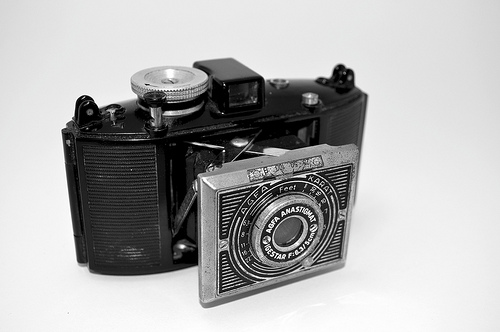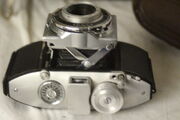Agfa Karat
The Agfa Karats are two series of strut-folding cameras made by Agfa from the mid-1930s until the mid-1950s. The Karat came with a new film cartridge that was later to be used in the Ansco Memo (Ansco had been producing items under Agfa license since 1928). Compared to the Memo cassette, the Karat cassette was physically smaller, holding less film (12 full frames vs. 24), and had a modified shape.[1] The camera has to be loaded with a cartridge in which the film is provided and an empty cartridge of the same type. The film advance mechanism of the camera transfers the film step by step out of the one into the other cartridge. The piece of film lying inside the camera between the cartridges will always be fixed perfectly in the focal plane. The Karat cartridges are a light-tight version of a an older cartridge type of Agfa. 27 years later the Karat cartridges were revived as Agfa’s Rapid film system. In 1948 the Karat 36 appeared that broke the tradition and used the standard 35mm film cassette.
Karat 6.3 Art Deco Edit
Edit

Karat 6.3 Art Deco
 |
| Karat 6,3 Art Decoimage by Raúl Sá Dantas (Image rights) |
The first Karat has an unusual looking rounded cast aluminum body covered with a durable black synthetic material. The top cover is also rounded; both it and the flat bottom cover are painted black. The collapsible front plate, supported by four scissors struts, has an Art Deco style insert that has the shutter & f/stop settings. On the cast top cover is the shutter release and sliding time exposure lock, a Galilean tube viewfinder, a window for the internal frame counter, and the film advance knob, which interlocks with the Agfa self-cocking shutter for double exposure prevention. Also on the top cover are two strap lugs, and a release button to extend the lens standard, which locks in place. The lens standard release to allow the collapsing of the camera is on the left front of thew camera.
- Year of release: 1936
- Film Format: 35mm 12 exp in Rapid cassette
- Shutter: Agfa Automat B 25 50 100 (self cocking)
- Lens: Igestar 6.3/50 (three elements)
- Aperture: 6.3 to 22
- Viewfinder: optical direct vision viewfinder
- Flash: None
Karat 6.3 Edit
Edit
 |
| Karat 6.3 image by Randy Clark (Image rights) |
Similar to the Karat 6.3, the Karat has a larger viewfinder, an external frame counter on the top cover, and a simplified front plate. The lens settings are now on the lens bezel instead of the front plate, and the shutter time exposure lock is relocated to the front, between the top cover and the body. The camera now lacks strap lugs.
- Year of release: 1938
- Film Format: 35mm 12 exp in Rapid cassette
- Shutter: Agfa Automat B 25 50 100 (self cocking)
- Lens: Igestar 6.3/55 (three elements)
- Aperture: 6.3 to 22
- Viewfinder: optical direct vision viewfinder
- Flash: None

Agfa Karat 4.5 photo by Jeff Burke
Karat 4.5 Edit
Edit
Similar to the Karat 6.3, the Karat 4.5’s most noticeable difference is the use of brushed aluminum top and bottom covers. This model has an improved lens when compared to the two earlier models.
- Year of release: 1938
- Film Format: 35mm 12 exp in Rapid cassette
- Shutter: prontor B 25-125 (self cocking)
- Lens: Oppar 4.5/55 (four elements)
- Aperture: 4.5 to 32
- Viewfinder: optical direct vision viewfinder
- Flash: None
Karat 3.5 Edit
Edit

Karat 3.5 image by John Nuttall
The last of the rounded body Karats. Similar to the Karat 4.5, the Karat 3.5’s most significant difference is the use of Deckel’s Compur and Gauthier’s Prontor shutters. As these shutters are not self-cocking, a simple but ingenious method is used to remind the user to cock the shutter before shooting: when cocked, the shutter cocking lever is clearly visible in the viewfinder. The Karat 3.5 originally featured a 5cm f/3.5 Solinar lens; after the war, this was changed to the less expensive 55mm f/3.5 Apotar lens. Early Karat 3.5 models had a cast aluminum top cover with strap lugs and an aperture plate attached to the front lens standard. Later models had stamped covers and aperture scales on the lens bezel.
- Year of release: 1938
- Film Format: 35mm 12 exp in Rapid cassette
- Shutter: Compur-Rapid B 1-500; Compur B 1-300; Prontor B 1-250; Prontor S 1-300
- Lens: Agfa Solinar 3.5/50 (pre-war, 4 elements) or Agfa Apotar 3.5/55 (post-war, 3 elements); both front cell focusing
- Aperture: 3.5 to 32
- Viewfinder: optical direct vision viewfinder
- Flash: Models with Prontor S
Karat 12 / Karat 2.8 Edit
Edit
 |
| Karat 12 image by old_cameras (Image rights) |
The Karat 2.8 was the first of the second series of Agfa Karats. It was later called the Karat 12 to differentiate it from the newer Karat 36. The lens standard and bellows arrangement are basically identical to the Karat 3.5, while the body is entirely new. The Karat 12 has a combined viewfinder/rangefinder and a lever wind. The unusual rangefinder, different from most, shifted the entire upper and lower halves of the viewfinder image when focusing. The film advance lever is also unusual in that it operates in the opposite direction (front to back), similar to the later Alpa reflexes. Another upgrade to the Rapid series is a depth-of-field dial located on the top cover where a rewind knob would be on a traditional 35mm camera, and a film reminder dial, located above the right viewfinder window. The film counter has been moved to the right side of the camera, and shutter time exposure lock and lens release button have been relocated as well. Post-war models have a mushroom shaped shutter release.
Sources vary as to the introduction of the Karat 12, most stating either 1941 or 1945. The example shown here has a pre-war Schneider Xenar lens dating from September 1935, indicating that the Karat 12 was probably in production well before 1941. At any rate, due to the war, introducing a new consumer camera as late as 1941 seems unlikely. (edit: The mushroom shaped shutter release, the 5 digit lens serial number and the presence of an accessory shoe all suggest that the example shown is a post-war model.)
Note: post-war Karats of this model with Schneider lenses did not use the normal Schneider lens serial number sequence, instead using a low five digit number.
- Year of release: 1941?
- Film Format: 35mm 12 exp in Rapid cassette
- Shutter: Compur B 1-300; Compur-Rapid B 1-500
- Lens: Schneider-Kreuanach Xenar 2.8/50 (five elements); unit focusing
- Aperture: 2.8 to 16
- Viewfinder: Split image Rangefinder
- Flash: Some with Compur-Rapid
Karat 36 Edit
Edit
 |
| Karat 36 image by Alfred Sigaro (Image rights) |
With the Karat 36, the series moved from the Rapid cassettes to the Kodak 35mm cartridge, though the Karat 12 remained in production for several more years. Outwardly nearly identical to the Karat 12, the most notable differences were: a film rewind knob replacing the depth-of-field dial (which now replaces the film reminder dial) on the top cover, a rewind button on the bottom cover, a folding articulated film advance lever, elimination of the lens release lever (the body mounted lens release lever now performs that function), an accessory shoe, and a shutter time exposure lock that rotates rather than slides.
Later models of the Karat 36 replaced the folding articulated advance lever extension with a non-folding lever with a larger cylindrical knob, eliminated the shutter time exposure lock, replaced the top depth-of-field dial with a more modern depth-of-field scale on the front lens standard, and have a shorter shutter release.
 |
| Karat 36 early image by Jack Hufnagel (Image rights) |
The Karat 36’s top engravings varied significantly over the years.
The Ansco Karomat were re-badged versions of the Karat 36 cameras produced for the American Market. In 1953, it sold for $164US (over $1200 in 2007 US dollars – these were not cheap cameras!) At the same time, a comparable Contax IIA cost $440, and a comparable Leica IIIc cost $385.
- Year of release: 1948
- Film Format: 35mm
- Shutter: Compur-Rapid B 1-500; Synchro-Compur B 1-500
- Lens: Agfa Solinar 2.8/50 (four elements); Agfa Solagon 2.0/50; Rodenstock Heligon 2.0/50; SchneiderXenon 2.0/50 (all six elements)
- Aperture: 2.0 or 2.8 to 16
- Viewfinder: optical viewfinder with superimposed rangefinder
- Flash: X-, V- and M-synchronization
Karat IV Edit
Edit
 |
| Karat IV image by Matt Phillips (Image rights) |
The Karat IV upgrades the Karat 36 with a more conventional superimposed rangefinder and revised top cover.
- Film Format: 35mm
- Shutter: Prontor-SVS
- Lens: Agfa Solinar 2.8/50 (four elements); Agfa Solagon 2.0/50; Rodenstock Heligon 2.0/50; SchneiderXenon 2.0/50 (all six elements)
- Aperture: 2.0 to 16
- Viewfinder: optical viewfinder with superimposed rangefinder
- Flash: X-, V- and M-synchronization
References Edit
Edit
- ↑ Agfa Memo
Bibliography  Edit
Edit
Original documents
- W.D. Emanuel, Agfa Karat Guide, Focal Press, 1951
Repair Notes  Edit
Edit
One of the most common faults on the Karat is that the focussing mechanism seizes. The grease used turns to glue. Forcing the focus lever spreads two legs that stabilize the lens and mechanism. On early Karats, the link to the rangefinder on one of these legs is screwed from underneath, making it necessary to partially remove the bellows, but on the 36, the screw is from the top making it easy to disconnect the rangefinder. It is then possible to undo the mechanism retaining ring inside the camera and drop the mechanism and lens out, leaving the bronze focussing mechanism exposed and possible to free up. One recently required heat from a hair drier to loosen the two pieces, but most just require oiling to free up, then cleaning, then re-greasing. Laurie Pettitt (Learning the hard way)












暂无评论